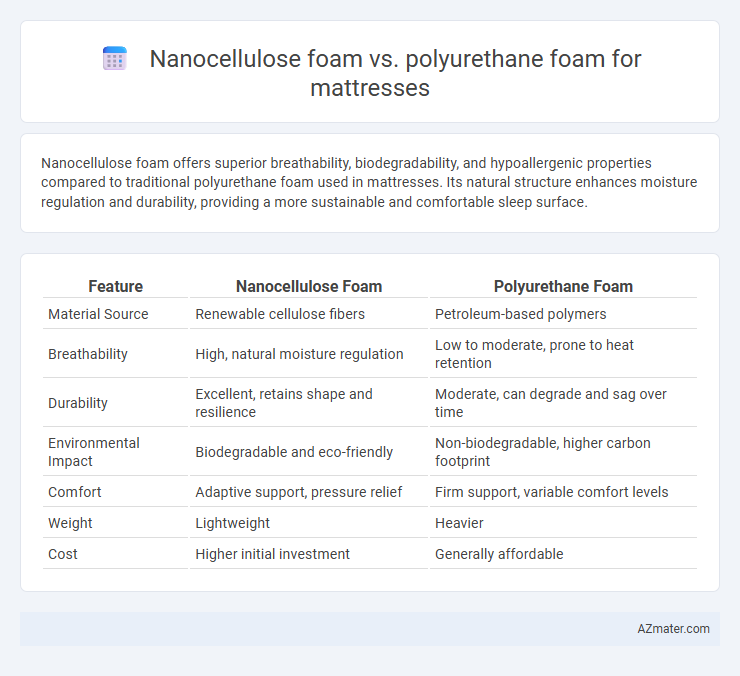Nanocellulose foam offers superior breathability, biodegradability, and hypoallergenic properties compared to traditional polyurethane foam used in mattresses. Its natural structure enhances moisture regulation and durability, providing a more sustainable and comfortable sleep surface.
Table of Comparison
| Feature | Nanocellulose Foam | Polyurethane Foam |
|---|---|---|
| Material Source | Renewable cellulose fibers | Petroleum-based polymers |
| Breathability | High, natural moisture regulation | Low to moderate, prone to heat retention |
| Durability | Excellent, retains shape and resilience | Moderate, can degrade and sag over time |
| Environmental Impact | Biodegradable and eco-friendly | Non-biodegradable, higher carbon footprint |
| Comfort | Adaptive support, pressure relief | Firm support, variable comfort levels |
| Weight | Lightweight | Heavier |
| Cost | Higher initial investment | Generally affordable |
Introduction to Mattress Foam Materials
Nanocellulose foam and polyurethane foam represent two distinct categories of mattress foam materials, each with unique properties affecting comfort and sustainability. Nanocellulose foam, derived from plant-based cellulose fibers, offers exceptional breathability, biodegradability, and mechanical strength, making it an eco-friendly alternative. Polyurethane foam, widely used in mattresses for its affordability and cushioning performance, often contains petrochemical components and varies in density and firmness, impacting durability and support.
What is Nanocellulose Foam?
Nanocellulose foam is an innovative, eco-friendly material derived from cellulose fibers extracted from plants, offering high strength, lightweight properties, and excellent breathability compared to traditional foams. It features a porous structure that enhances airflow and moisture-wicking abilities, making it ideal for mattresses that require temperature regulation and comfort. Unlike polyurethane foam, nanocellulose foam is biodegradable and sustainable, reducing environmental impact while maintaining durability and support.
What is Polyurethane Foam?
Polyurethane foam is a versatile synthetic polymer widely used in mattresses for its excellent cushioning, durability, and support properties. It is produced by reacting polyols with diisocyanates, resulting in a lightweight, flexible material that can be tailored to different firmness levels and densities. This foam provides pressure relief and conforms well to body contours, making it a popular choice in the bedding industry compared to alternatives like nanocellulose foam.
Sustainability Comparison: Nanocellulose vs Polyurethane
Nanocellulose foam offers a sustainable alternative to polyurethane foam by being derived from renewable biomass such as wood pulp, significantly reducing reliance on fossil fuels. It boasts excellent biodegradability and low environmental impact throughout its lifecycle compared to the petroleum-based, non-biodegradable polyurethane foam. The production of nanocellulose foam generates fewer greenhouse gas emissions and avoids toxic chemicals, making it a greener choice for eco-conscious mattress manufacturing.
Comfort and Support: Performance Differences
Nanocellulose foam offers superior breathability and pressure distribution compared to polyurethane foam, enhancing comfort by reducing heat retention and promoting airflow. Polyurethane foam provides firmer support with more pronounced cushioning but may trap heat, potentially impacting sleep quality. The innovative structure of nanocellulose foam ensures adaptive support by contouring to body shape, resulting in improved spinal alignment and pressure relief.
Durability and Longevity
Nanocellulose foam exhibits superior durability and longevity compared to traditional polyurethane foam due to its higher tensile strength and resistance to compression set over time. This sustainable material maintains its structural integrity and cushioning properties longer, reducing sagging and deformation in mattresses. Polyurethane foam, while cost-effective, typically degrades faster under prolonged use, leading to loss of support and shorter mattress lifespan.
Breathability and Moisture Management
Nanocellulose foam exhibits superior breathability compared to polyurethane foam due to its highly porous nanostructure, promoting improved air circulation within the mattress. This enhanced ventilation facilitates effective moisture management by quickly wicking away sweat and reducing heat retention, resulting in a cooler sleeping environment. In contrast, polyurethane foam tends to trap heat and moisture, potentially causing discomfort and reduced mattress freshness over time.
Environmental Impact and Biodegradability
Nanocellulose foam offers superior environmental benefits compared to polyurethane foam due to its renewable origin from cellulose fibers and minimal reliance on fossil fuels. It exhibits excellent biodegradability, breaking down naturally within months without releasing toxic residues, while polyurethane foam persists in landfills for decades, contributing to microplastic pollution. The production of nanocellulose foam generates significantly lower carbon emissions and involves fewer hazardous chemicals, making it a sustainable alternative for eco-conscious mattress manufacturing.
Cost Considerations and Market Availability
Nanocellulose foam is generally more expensive than polyurethane foam due to higher production costs and limited large-scale manufacturing facilities. Polyurethane foam dominates the mattress market with widespread availability and numerous cost-effective options that cater to various consumer budgets. Limited commercial production and niche applications restrict nanocellulose foam's accessibility, making it a premium alternative in mattress construction.
Which Foam is Better for Mattresses?
Nanocellulose foam offers superior breathability, biodegradability, and hypoallergenic properties compared to polyurethane foam, making it a more sustainable and health-friendly option for mattresses. Polyurethane foam excels in durability, cost-effectiveness, and a wide range of firmness options, which contributes to its popularity in mattress manufacturing. When choosing the better foam for mattresses, consideration of environmental impact, comfort preferences, and budget is essential, with nanocellulose foam often favored for eco-conscious consumers and polyurethane foam preferred for affordability and versatility.

Infographic: Nanocellulose foam vs Polyurethane foam for Mattress
 azmater.com
azmater.com